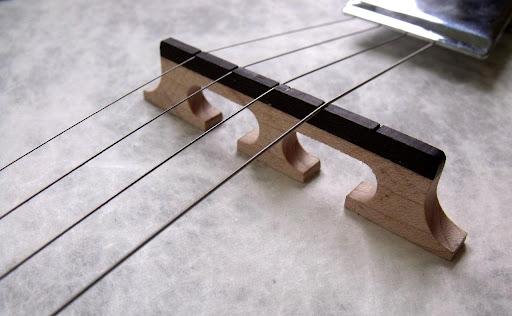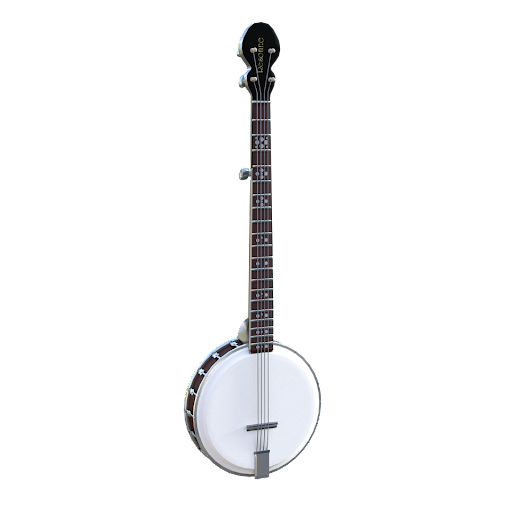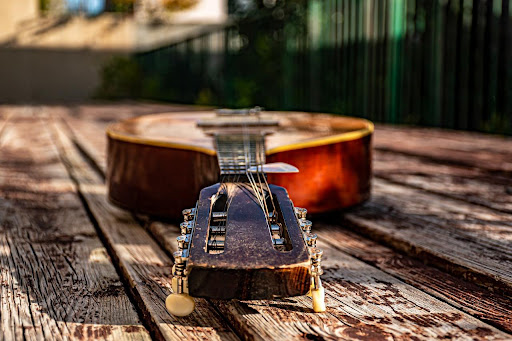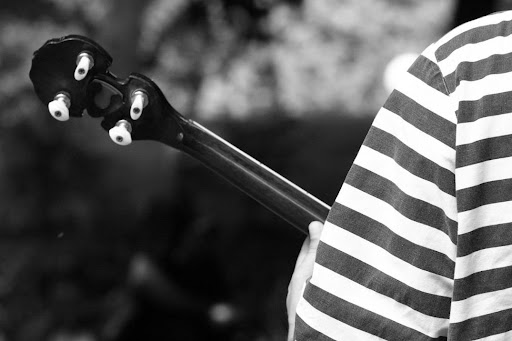Like every string instrument, the banjo lets the players play it in two ways: with or without a pick. This brings up the crucial question of what exactly is a pick. A finger pick is a small layer of metal or plastic that you can wear on your fingers while playing any stringed instrument.
You usually wear a finger pick at the tip of your playing finger and thumb. Picks provide a protective layer of material to the fingers and help the player use the instrument more confidently.
Many beginners worry about playing the strings hard for fear of being hurt or breaking the string. Wearing a pick lets the player firmly play the strings, contributing to better tone and music.
The benefits of wearing finger picks for banjo are countless.The following article explores the world of banjo picks and traces the evolution and current status of banjo picks in particular. The article will be helpful to know how to hold a banjo pick and the best thumb picks for banjo.
The Different Types of Banjo Picks and Their Unique Qualities
Banjo picks are primarily two types.
1) Finger Picks
2) Thumb Picks
Finger Picks
As the name points out, fingerpicks are worn on the playing finger other than the thumb. Finger picks are available in many shapes and sizes. They are available in material variations also. The most common materials used to make finger picks are:
- Metal
- Plastic
- Nylon
Metal and plastic are the most common pick materials used for banjos. Both have a share of pros and cons in the metal vs. plastic banjo picks debate.
Metal picks provide high precision in playing and also help to produce louder sounds. Plastic picks are best for creating soft sounds and mellow music.
Thumb Picks
Thumb picks, as the name indicates, are worn on the thumb of the player. These are also available in various materials, sizes, and shapes. The most popular materials used to make thumb picks are:
- Plastic
- Vinyl
- Nylon
- Metal
Plastic, Nylon, and Vinyl help to make relatively softer sounds on a banjo. But metal thumb picks to create a much sharper and stronger tone on a banjo. Depending on the playing technique also, the picks create varying sounds.
How toChoose theRight Banjo Pick forYour Playing Style?
Finding an ideal pick can contribute a lot to the banjo-playing style of a person. Picks are generally inexpensive, so players can try multiple picks before settling for one.
The following section provides information on several basic features the player must look for while purchasing a banjo pick.
Material of the Pick
- Various materials, like plastic, nylon, vinyl, metal, etc., are used for making finger picks and thumb picks.
- Plastic thumb picks are best suited for three-stringed banjos.
- Plastic thumb picks make a much lower or mellower sound than metal ones.
- Metal picks are the most flexible ones and one of the most popular ones.
- Due to the positives of plastic and metal thumb picks, picks are available with a plastic blade and a metal band.
- Plastic-metal fusion picks are generally more expensive than all-plastic or all-metal picks.
- Metal thumb picks are relatively durable.
- Metal thumb picks require regular cleaning.
- The most popular metals used to manufacture banjo picks are nickel, brass, cobalt, and stainless steel.
Length of the Pick
- The length of the pick can influence the convenience of the player and the sound that is produced.
- Both short and long banjo picks are available in the market.
- Short picks are best suited for beginners, as they are much more handy.
- But, once the player becomes an expert in banjo, they usually prefer long picks.
- Long picks are the best because of the high scope of playing that they offer
- Long picks offer more range than shorter ones.
- Longer picks can also be adjusted and personalized to benefit the player.
The angle of the Pick
- Banjo picks are available in a wide variety of angles.
- The pick must touch the string squarely to make a rich and clean sound.
- So, depending on the player’s finger shape and hand position, their banjo picks should be appropriately built to achieve the right angle.
- Banjo picks are available in both sharp and smooth angles.
- Players who have arthritis usually choose sharp-angled banjo picks to compensate for their finger angle.
Fit of the Pick
- The pick’s fit is crucial to achieving the right tone and sound.
- The size and shape of the player’s fingers should be the primary concern when purchasing a banjo pick.
- Purchasing a banjo pick that is too tight or loose would only disturb the sound quality produced.
- The best way to identify the right fitting banjo pick is to try as many products as possible.
- Larger banjo players usually prefer larger picks.
- Depending on the brand of the pick also, the fit varies
- Metal picks are compatible with a physical adjustment.
- Slight alterations can be made to the plastic picks using boiling water
The gauge of the Pick
- Gauges are available between light and heavy range
- The light range starts at 0.13, and the heavy range ends at 0.25
- Heavy gauged picks produce loud sounds and are relatively more durable.
- Lighter gauges support the production of mellower and thinner sounds.
- Lighter gauges are much more flexible than the heavy ones.
- Beginners usually prefer heavy gauges as they produce loud sounds and are much more convenient to play.
- Experts usually prefer lighter gauges due to the extra flexibility.
- Experts advise beginning banjo playing with a 0.25 gauge
Banjo Picks for Different Genres of Music
The different genres of music demand different styles of banjo playing and techniques. As the nature of the banjo picks can influence the sound produced, their selection depends on the kind of music the player intends to
create.
The pick choice is usually inspired by the type of music the player wants to play. For bluegrass players, loud music is a necessity. So, they mostly prefer heavier picks as they can create a lot of volumes.
A delicate sound is appropriate for soul music and similar softer and mellower-style music. So, a lighter banjo pick is suitable for such music genres. Many pop musicians attempt to gain the positives of plastic and metal banjo picks by combining them into a hybrid one.
The History and Evolution of Banjo Picks
Although the written recordsmostly point to the late 1800s as the original period of banjo picks, a good look at the history reveals that they existed in different forms and shapes in a much older period.
The section below traces the evolution and journey of banjo picks to their current status.
Origin- Iran and India
- The need for external tools like picks emerged due to the inadequacy of bare fingers in producing loud music.
- First picks were produced to play ancient instruments like the Iranian sitar, tambura, etc.
- During 300 AD, wire picks were made to improve the sitar playing technique.
- The initial models of picks were known by the name mezcal.
- Mezrab model consists of a metal ring and a wire loop.
- By the 17th century, picks became common in the Indian subcontinent as complementary tools for the Indian Sitar.
Japan and China
- Musicians in Japan developed finger picks called Tsume, specifically used to play local stringed instruments like Koto.
- Tsume was made of bone and available in square and round shapes.
- Tsume was polished very well to help make a smoother sound.
- Tsume was worn on three fingers of the musician’s hand: index, middle, and thumb.
- China has been using ancient finger picks for their stringed instruments, similar to the Japanese Koto.
- The only difference between Japanese and Chinese picks is the material. While Japanese pick is made of bone, Chinese pick is made of animal horns.
- Also, Chinese picks are usually worn on four fingers: index, middle, ring, and thumb.
Portugal
- Portugal is another country where ancient models of banjo picks existed.
- Portuguese finger picks were known by the name Unhas.
- Thin sheets of plastic were primarily used to make Unhas.
- Original models of Portuguese fingerpicks used materials like tortoise shells.
- The edges and tips of the Unhas were connected to the lower part of the fingernail for better fitting and convenient playing.
Summary
Banjo players usually play banjo with either their bare hands or using a pick. A banjo pick is a device that is worn on the fingers of the player that helps to produce better quality music.
Many options are available in banjo picks that span oversize, length, material, gauge, etc. Despite picks being in high demand recently, they have existed for quite a long time. In countries like Iran, India, Japan, China, Portugal, etc., traces remain of ancient fingerpicks.
FAQs
1. Are banjos played with a pick?
A Banjo pick is not a must-have for a banjo player. An expert banjo player can create music with their bare hands. But banjo picks do make the playing a bit more convenient. They also help beginners achieve the desired quality in playing.
2. What is the best pick for a banjo?
The best pick for a banjo is a 0.25 gauge one. These heavy gauged banjo picks help produce loud and more precise sounds. For beginners, this pick helps in understanding the sound better and clearer, which enables them to find the faults in their playing and improve.








